Agreeing & Disagreeing ESL Activities, Games & Worksheets
Areas of Agreement
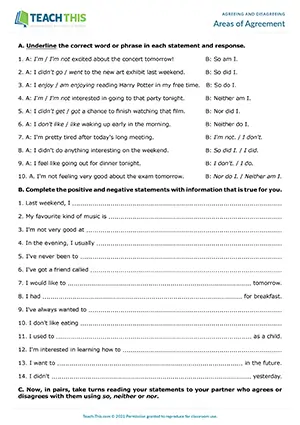
ESL So, Neither or Nor Activity - Grammar and Speaking: Binary Choice, Sentence Completion, Reading and Responding to Statements - Pair Work
In this engaging agreeing and disagreeing activity, students practice agreeing and disagreeing with positive and negative statements using so, neither or...
Neither and So
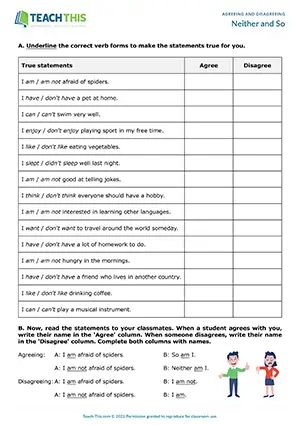
ESL Neither and So Activity - Speaking: Making and Responding to Statements, Communicative Practice
In this communicative neither and so speaking activity, students agree and disagree with positive and negative statements using neither and so. First, students underline the correct verb form in each statement...
Disagree with me
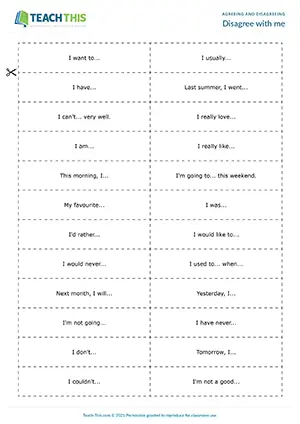
ESL Agreeing and Disagreeing Game - Speaking and Grammar: Sentence Completion, Freer Practice - Group Work
Here is an amusing agreeing and disagreeing game to help students practice expressions of agreement and disagreement. In groups, students take turns selecting a card and completing the statement...
Do you agree?
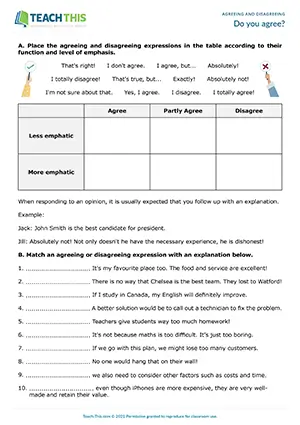
ESL Agreeing and Disagreeing Worksheet - Vocabulary Exercises: Categorising, Matching, Writing Sentences - Speaking Activity: Sharing Opinions - Pair Work
In this free agreeing and disagreeing worksheet, students learn and practice phrases for agreeing and disagreeing with opinions. First, students...
Fire! Fire!

ESL Agreeing and Disagreeing Activity - Speaking: Asking and Answering Questions, Ranking, Communicative Practice - Pair Work
In this agreeing and disagreeing speaking activity, students discuss which items to save in a house fire. In pairs, students imagine that they share a house which...
I couldn't agree more

ESL Agreeing and Disagreeing Worksheet - Vocabulary Exercises: Matching, Gap-fill, Writing Sentences - Speaking Activity: Discussion, Opinion Sharing - Pair Work
In this useful agreeing and disagreeing worksheet, students practice phrases showing various levels of agreement or disagreement. First...
Me Neither
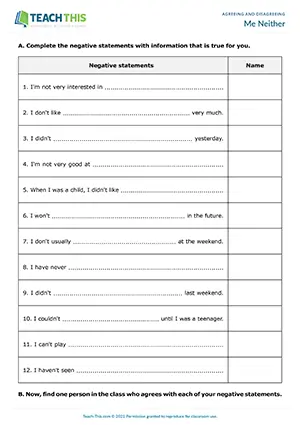
ESL Neither and Nor Activity - Speaking: Sentence Completion, Responding to Statements, Communicative Practice
This communicative neither and nor speaking activity helps students to practice agreeing with negative statements using neither and nor. First, students complete negative statements with information...
So, Neither or Nor?
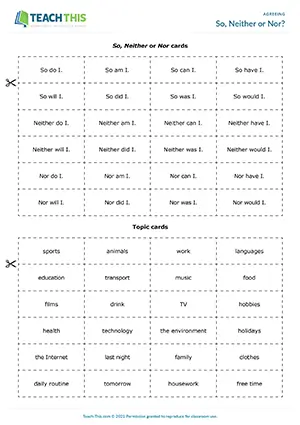
ESL So, Neither or Nor Game - Speaking: Making and Responding to Statements - Group Work
In this entertaining agreeing game, students race to agree with statements using so, neither or nor. In groups, students take turns picking up a topic card and showing it to the group, e.g. sports. The...
I'd Go Along With That

ESL Agreeing and Disagreeing Worksheet - Vocabulary Exercises: Gap-fill, Matching, Binary Choice, Error Correction - Speaking Activity: Discussion, Freer Practice
In this comprehensive agreeing and disagreeing worksheet, students practice advanced phrases used to agree, partially agree, and disagree...
React

ESL Agreeing, Disagreeing and Showing Surprise Activity - Speaking: Role-Play, Making and Responding to Statements, Communicative Practice
This fun agreeing and disagreeing role-play activity helps students practice language for expressing agreement, disagreement and surprise. First, students read...
School Improvements
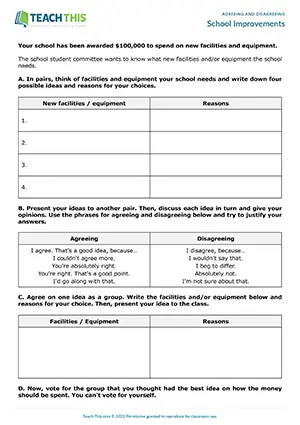
ESL Agreeing and Disagreeing Activity - Speaking: Providing Ideas and Reasons, Presenting, Discussion, Communicative Practice - Pair and Group Work
In this communicative agreeing and disagreeing speaking activity, students agree and disagree on how money should be spent on school facilities and...
Would you agree?

ESL Agreeing and Disagreeing Game - Vocabulary and Speaking: Binary Choice, Writing Sentences, Discussion, Communicative Practice - Group Work
This free agreeing and disagreeing game helps students practice various phrases for stating an opinion, asking for an opinion, agreeing and disagreeing...

